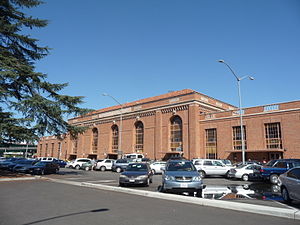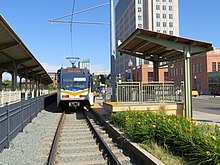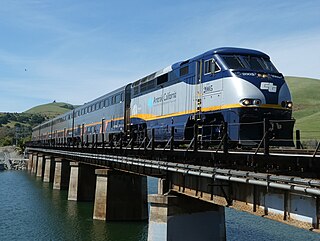
The Capitol Corridor is a 168-mile (270 km) passenger train route in Northern California operated by Amtrak between San Jose, in the Bay Area, and Auburn, in the Sacramento Valley. The route is named after the two points most trains operate between, San Jose and Sacramento. The route runs roughly parallel to I-880 and I-80. Some limited trips run between Oakland and San Jose. A single daily round trip runs between San Jose and Auburn, in the foothills of the Sierra Nevada. Capitol Corridor trains started in 1991.

The San Joaquins is a passenger train service operated by Amtrak in California's San Joaquin Valley. Six daily round trips run between its southern terminus at Bakersfield and Stockton, with onward service to Sacramento and Oakland.

Saint Paul Union Depot is a historic railroad station and intermodal transit hub in the Lowertown neighborhood of Saint Paul, Minnesota. It serves light rail, intercity rail, intercity bus, and local bus services.

Amtrak California is a brand name used by the California Department of Transportation (Caltrans) Division of Rail for three state-supported Amtrak regional rail routes in California – the Capitol Corridor, the Pacific Surfliner, and the San Joaquins – and their associated connecting network of Amtrak Thruway transportation services.

Richmond station is an Amtrak intercity rail and Bay Area Rapid Transit (BART) station located in downtown Richmond, California. Richmond is the north terminus of BART service on the Orange Line and Red Line; it is a stop for Amtrak's Capitol Corridor, San Joaquins, and California Zephyr routes. The accessible station has one island platform for the two BART tracks, with a second island platform serving two of the three tracks of the Union Pacific Railroad Martinez Subdivision for Amtrak trains. It is one of two transfer points between BART and Amtrak, along with Oakland Coliseum station.

Emeryville station is an Amtrak station in Emeryville, California, United States. The station is served by the California Zephyr, Capitol Corridor, Coast Starlight, and San Joaquins. The station is the primary connection point for Amtrak Thruway buses serving San Francisco.
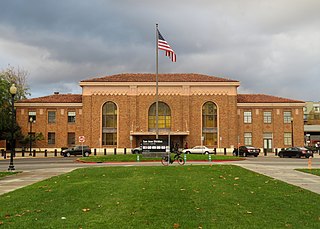
San Jose Diridon station is the central passenger rail depot for San Jose, California. It also serves as a major intermodal transit center for Santa Clara County and Silicon Valley. The station is named after former Santa Clara County Supervisor Rod Diridon Sr.

Burbank Airport–South station, referred to as Hollywood Burbank Airport station by Amtrak and formerly known as Bob Hope Airport station, is an unstaffed Amtrak and Metrolink train station on the southeast corner of Hollywood Burbank Airport in the city of Burbank, California. Amtrak's Pacific Surfliner from San Luis Obispo to San Diego, Amtrak's Coast Starlight from Los Angeles to Seattle, Washington, and Metrolink's Ventura County Line from Los Angeles Union Station to East Ventura stop here.

The Glendale Transportation Center is an Amtrak and Metrolink train station in the city of Glendale, California. It is served by the Amtrak Pacific Surfliner intercity rail route and the Metrolink Ventura County Line and Antelope Valley Line commuter rail routes.
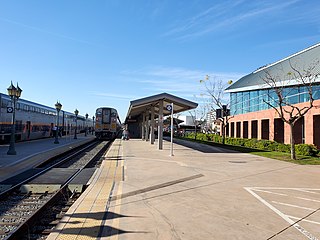
Bakersfield station is an intermodal facility in Bakersfield, California. It is the southern terminus of Amtrak California's San Joaquins route, with Amtrak Thruway buses continuing to Amtrak stations and bus stops throughout Southern California and Nevada. The station opened with a celebration on July 4, 2000. It contains an 8,300-square-foot (770 m2) train station with two platforms and three tracks, as well as a 17-bay bus station.

Martinez station is an Amtrak passenger train station in Martinez, California, United States. Located at the west end of downtown Martinez, the station has one side platform and one island platform, which serve three of the four tracks of the Union Pacific Railroad Martinez Subdivision. It is served by the daily California Zephyr and Coast Starlight long-distance trains, five daily round trips of the San Joaquin corridor service, and fifteen daily round trips of the Capitol Corridor service. Martinez is also served by Amtrak Thruway buses plus County Connection, Tri-Delta Transit, and WestCAT local buses.

Reno station is an Amtrak intercity train station in Reno, Nevada, served by the California Zephyr train. It is also serviced by five times per weekday, and twice on weekends, Amtrak Thruway routes to Sacramento.

Truckee station is an Amtrak train station in Truckee, California.

Robert J. Cabral Station, is a railway station in Stockton, California. In 2003, the station building was named in honor of the late Robert J. Cabral, a San Joaquin County supervisor instrumental in the creation of the Altamont Corridor Express (ACE), originally Altamont Commuter Express.

Lodi Transit Station, or simply Lodi station, is an intermodal transit facility in Lodi, California. It serves the San Joaquins rail line, is the hub for the local Lodi GrapeLine bus service and is also served by other intercity buses.

The Salt Lake City Intermodal Hub is a multi-modal transportation hub in Salt Lake City, Utah, United States served by the Blue Line of UTA's TRAX light rail system that operates in Salt Lake County and by the FrontRunner, UTA's commuter rail train that operates along the Wasatch Front with service from Ogden in central Weber County through Davis County, Salt Lake City, and Salt Lake County to Provo in central Utah County. Service at the intermodal hub is also provided by Amtrak, and Greyhound Lines, as well as UTA local bus service.

Redding station is an intercity train station served by Amtrak's Coast Starlight, located in Redding, California, United States. The depot was built by the Southern Pacific Railroad in 1923 and opened on February 5, 1924. The train station has sheltered waiting areas on both platforms and a parking lot near the southbound platform.

Sacramento RT Light Rail is a 42.9-mile (69.0 km) light rail system that serves the Sacramento, California area. It consists of three rail lines, 53 stations, and a fleet of 96 vehicles. It is operated by the Sacramento Regional Transit District (RT). With an average of 22,200 weekday daily boardings as of the fourth quarter of 2023, the RT light rail system is the thirteenth busiest in the United States.
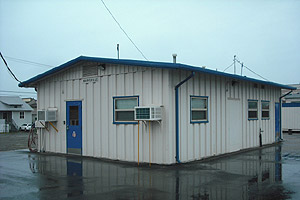
Marysville station was the last passenger rail station to operate in Marysville, California.
The Sacramento Subdivision is a rail line owned and operated by the Union Pacific Railroad in the U.S. state of California. The line begins in Marysville as a continuation of the Canyon Subdivision at a junction with the Valley Subdivision, and travels south through the Central Valley to a junction with the Fresno Subdivision in Stockton. South of Downtown Sacramento, the Sacramento RT Light Rail Blue Line runs adjacent to the right of way until a flyover near Consumnes River Boulevard. The route between Sacramento and Stockton hosts about 12 to 20 freight trains daily as of 2018. Additionally, the Amtrak Coast Starlight runs over the tracks between Marysville and Sacramento.
